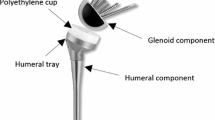Abstract
In vitro mechanical testing of orthopedic implants provides information regarding their mechanical performance under simulated biomechanical conditions. Current in vitro component stability testing methods for reverse shoulder implants are based on anatomical shoulder designs, which do not capture the dynamic nature of these loads. With glenoid component loosening as one of the most prevalent modes of failure in reverse shoulder replacements, it is important to establish a testing protocol with a more realistic loading regime. This paper introduces a novel method of mechanically testing reverse shoulder implants, using more realistic load magnitudes and vectors, than is currently practiced. Using a custom made jig setup within an Instron mechanical testing system, it is possible to simulate the change in magnitude and direction of the joint load during arm abduction. This method is a step towards a more realistic testing protocol for measuring reverse shoulder implant stability.








Similar content being viewed by others
References
Ackland, D. C., S. Roshan-Zamir, M. Richardson, and M. G. Pandy. Muscle and joint-contact loading at the glenohumeral joint after reverse total shoulder arthroplasty. J. Orthop. Res. 29:1850–1858, 2011. doi:10.002/jor.21437 (Epub 2011 May 12).
Anglin, C., U. P. Wyss, R. W. Nyffeler, and C. Gerber. Loosening performance of cemented glenoid prosthesis design pairs. Clin. Biomech. (Bristol, Avon) 16:144–150, 2001.
Boileau, P., D. J. Watkinson, A. M. Hatzidakis, and F. Balg. Grammont reverse prosthesis: design, rationale, and biomechanics. J. Shoulder Elbow Surg. 14:147S–161S, 2005.
Codsi, M. J., and J. P. Iannotti. The effect of screw position on the initial fixation of a reverse total shoulder prosthesis in a glenoid with a cavitary bone defect. J. Shoulder Elbow Surg. 17:479–486, 2008; (Epub 2008 Feb 20).
Cuff, D., D. Pupello, N. Virani, J. Levy, and M. Frankle. Reverse shoulder arthroplasty for the treatment of rotator cuff deficiency. J. Bone Joint Surg. Am. 90:1244–1251, 2008. doi:10.2106/JBJS.G.00775.
Frankle, M., J. C. Levy, D. Pupello, S. Siegal, A. Saleem, M. Mighell, and M. Vasey. The reverse shoulder prosthesis for glenohumeral arthritis associated with severe rotator cuff deficiency. A minimum two-year follow-up study of sixty patients surgical technique. J. Bone Jt. Surg Am. 88:178–190, 2006.
Gallo, R. A., S. C. Gamradt, C. J. Mattern, F. A. Cordasco, E. V. Craig, D. M. Dines, and R. F. Warren. Instability after reverse total shoulder replacement. J. Shoulder Elbow Surg. 20:584–590, 2011. doi:10.1016/j.jse.2010.08.028; (Epub 10 Dec 16).
Harman, M., M. Frankle, M. Vasey, and S. Banks. Initial glenoid component fixation in “reverse” total shoulder arthroplasty: a biomechanical evaluation. J. Shoulder Elbow Surg. 14:162S–167S, 2005.
Hopkins, A. R., U. N. Hansen, A. M. Bull, R. Emery, and A. A. Amis. Fixation of the reversed shoulder prosthesis. J. Shoulder Elbow Surg. 17:974–980, 2008. doi:10.1016/j.jse.2008.04.012; (Epub 08 Aug 28).
International ASTM. Standard Test Methods for Dynamic Evaluation of Glenoid Loosening or Disassociation. In: F2028-08. West Conshohocken: ASTM International, 2008.
Kontaxis, A., and G. R. Johnson. The biomechanics of reverse anatomy shoulder replacement—a modelling study. Clin. Biomech. (Bristol, Avon) 24:254–260, 2009.
Lam, F., D. N. Bhatia, S. B. Mostofi, K. van Rooyen, and J. F. de Beer. Biomechanical considerations of the normal and rotator cuff deficient shoulders and the reverse shoulder prosthesis. Current Orthopaedics 21:40–46, 2007.
Tornier Surgical Implants. Surgical Technique: Shoulder Prosthesis—Aequalis-Reversed. http://depts.washington.edu/shoulder/Surgery/TornierAequalisReversedTechnique.pdf.
Mulieri, P., P. Dunning, S. Klein, D. Pupello, and M. Frankle. Reverse shoulder arthroplasty for the treatment of irreparable rotator cuff tear without glenohumeral arthritis. J. Bone Joint Surg. Am. 92:2544–2556, 2010. doi:10.106/JBJS.I.00912.
Poppen, N. K., and P. S. Walker. Normal and abnormal motion of the shoulder. J. Bone Joint Surg. Am. 58:195–201, 1976.
Terrier, A., A. Reist, F. Merlini, and A. Farron. Simulated joint and muscle forces in reversed and anatomic shoulder prostheses. J. Bone Joint Surg. Br. 90:751–756, 2008.
Walch, G., A. A. Young, P. Boileau, M. Loew, D. Gazielly, and D. Mole. Patterns of loosening of polyethylene keeled glenoid components after shoulder arthroplasty for primary osteoarthritis: results of a multicenter study with more than five years of follow-up. J. Bone Joint Surg. Am. 94:145–150, 2012. doi:10.2106/JBJS.J.00699.
Werner, C. M., P. A. Steinmann, M. Gilbart, and C. Gerber. Treatment of painful pseudoparesis due to irreparable rotator cuff dysfunction with the delta iii reverse-ball-and-socket total shoulder prosthesis. J. Bone Joint Surg. Am. 87:1476–1486, 2005.
Young, A. A., M. M. Smith, G. Bacle, C. Moraga, and G. Walch. Early results of reverse shoulder arthroplasty in patients with rheumatoid arthritis. J. Bone Joint Surg. Am. 93:1915–1923, 2011. doi:10.2106/JBJS.J.00300.
Acknowledgments
We would like to acknowledge Tornier Australia for providing implants and funding for this research.
Conflict of interest
Implants and funds for this study were supported by research funds donated by Tornier Australia.
Author information
Authors and Affiliations
Corresponding author
Additional information
Associate Editor Michael R. Torry oversaw the review of this article.
Rights and permissions
About this article
Cite this article
Dabirrahmani, D., Bokor, D. & Appleyard, R. A Novel Dynamic Mechanical Testing Technique for Reverse Shoulder Replacements. Ann Biomed Eng 42, 727–732 (2014). https://doi.org/10.1007/s10439-013-0942-z
Received:
Accepted:
Published:
Issue Date:
DOI: https://doi.org/10.1007/s10439-013-0942-z




